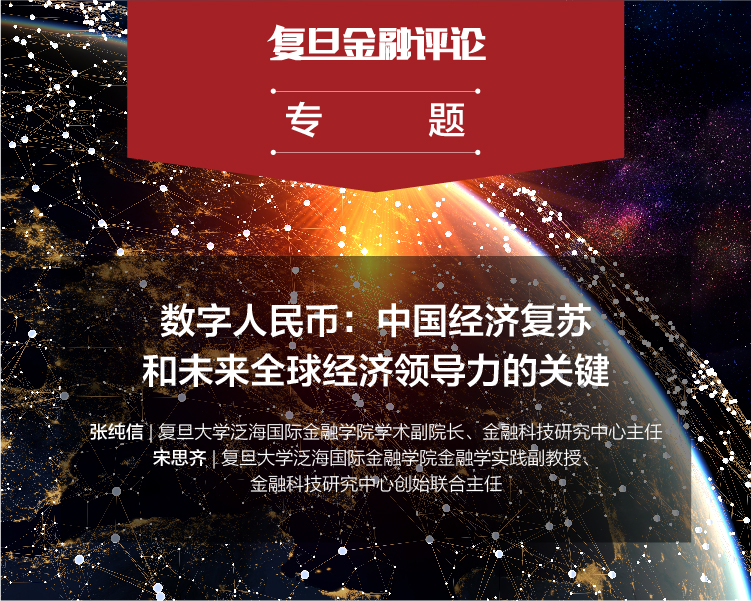数字人民币:中国经济复苏和未来全球经济领导力的关键

导语
数字人民币将极大驱动中国数字经济的发展,使中国摆脱疫情和全球经济危机的影响,开启复苏进程,并在未来成为全球无可争议的经济强国。

拉至底部,阅读英文原文
我们身处一个非同寻常的时代,新型冠状病毒肺炎疫情(下称“疫情”)于2020年初暴发,并演变成了一场全球“黑天鹅”事件,给全球社会造成巨大的痛苦和冲击。疫情使本已暗流涌动的经济雪上加霜,在全世界范围内可能会引发一场波及所有行业和社会阶层的金融危机。面对这一极为艰巨的挑战,中国做出了有效和令人钦佩的应对,推行了史无前例的防控措施。
这些积极措施非常有效地防止了疫情在中国的指数级传播。然而,中国为此付出了巨大的代价,疫情造成的生产力损失和长期经济收缩尚未得到充分评估。随着劳动力流动、交通运输、供应链和零售活动在全国范围内受疫情影响严重,中国的采购经理人指数(PMI)已经降至历史最低点。大型企业和中小企业都面临着惨淡的前景,三分之二的调查受访企业(甚至包括海底捞等资源丰富的大型企业)表示它们手头的现金不足维持几个月的运营。大量经济部门将面临系统性关闭,加之社会最脆弱的部门无法得到信贷支持,可能会导致全球有史以来最严重的经济衰退。尽管在2020年4月初,中国已经开始放松旅行限制,企业也开始恢复经营,但未来一段时间刺激中国经济的全面复苏仍是一项巨大的挑战。
应对疫情下的经济衰退,中央政府调控经济的“军火库”中可动用的一项关键潜在“武器”是由中国人民银行在2019年底宣布的数字人民币(Digital RMB)。作为由二十国集团(G20)成员国发行的首个央行数字货币(CBDC),数字人民币或将立即成为一种规模最大的、完全由法定货币背书的全球性数字货币。事实证明在这个机缘巧合的历史时点推出数字人民币,可以为中国人民银行提供一种以新技术加持的强大的货币政策和财政政策工具,以此来有效地刺激经济。
央行数字货币具备多重优越性

央行数字货币(CBDC)代表一种电子法定负债,发行国的中央银行可用它来进行支付结算。电子货币的概念以实时全额清算系统(real time gross settlement,RTGS)的形式存在了几十年,RTGS可以调节商业银行在央行持有的准备金余额。就央行数字货币而言,央行可能会发行具有普遍可获得性的法定货币,成为可供普通民众使用的支付方式,而不仅仅是商业银行的结算工具。正如中国人民银行此前表示,推出数字人民币的最初设想是取代M0货币供应,即流通中的票据及其他容易转换成现金的资产。
货币的三个特点是作为记账单位、价值储存和交换媒介。就这三个关键属性而言,数字货币比起实物形式的货币及其他相关货币工具更具优越性。目前,当普通人想用央行货币来储存价值和交换媒介时,唯一不会产生信用风险的可用选项就是纸币。因此,人们要承担安全处理和储存纸币的费用,如清点现金、存入银行账户。作为一个稳定的计账单位和储值工具,数字人民币在储值方面更为安全,因为它是由央行直接发行的法定货币,并不存在与私营企业支付平台或银行账户相关联的风险,后者都可能存在违约风险。作为交易中介,数字人民币可以实现无摩擦、低成本的交易,也可进行点对点交易,如手机的电子钱包可进行点对点的数字交易。作为一种几乎不需要成本的交易媒介,数字人民币将大大提高金融交易的结算效率和安全性,不论是零售交易还是跨境支付。
数字人民币改善市场效率

数字人民币能有效地将数字化存款的高效性和点对点现金交易的附加能力结合起来。由于中国现有的移动支付和其他数字支付系统的主导地位,中国已经基本实现了无现金化。有了数字人民币,就可以包含无风险的法定货币,从而在国内实现货币和支付的完全数字化。如果数字人民币最终也纳入银行存款,这些经济效益将会更加显著,在这种情况下,数字人民币可能会降低商业银行信贷中介的规模。例如,由英国央行(Bank of England)开发的模型显示,由于交易成本、实际利率以及扭曲性税收的降低,央行数字货币发行量占GDP30%的总量效应,GDP将有可能永久性地提高3%。
同时,把数字人民币引入整个生态系统将为无现金支付带来一个必要的替代选项。目前中国的无现金支付由微信支付和支付宝双头垄断,两者的综合市场份额超过线上零售支付交易总量的96%。数字人民币的引入可以使银行和其他金融机构参与竞争,成为可替代的金融服务提供商,这对于构建一个稳健、多元的支付生态系统是有益的。由此产生的金融部门也将变得更有竞争力,并为终端用户提供更多的实际益处。这也意味着现有的第三方支付系统将经历一次重组,将已经设立的金融机构纳入其中,并为该行业的监管创造更为有效的机会,降低金融系统的整体风险。事实上,随着法定货币的数字化,大数据分析和区块链相结合的信息技术将有更多协同增效的机会。交易的整个历史记录将被公开,为政策制定者提供大量的数据,用以监察市场中的不良参与者,或衡量经济受到冲击或政策变化时的反应。这种数据驱动和实时的模式,将显著提升行业内实时监测和监管的能力。
值得一提的是,数字人民币的支付效率将为低收入家庭和小型企业带来最明显的益处,而这些家庭和企业往往是经济衰退中承受能力最脆弱的。低收入家庭的支出通常严重依靠现金,而小型企业在处理现金、信用卡、借记卡等支付的交换/交易费用方面花费巨大。鉴于数字人民币的最初的重点是支持小额零售交易,并独立于国家的银行存款,它将为那些未充分获得银行服务的群体提供有效率、有弹性的金融服务。数字人民币可以降低大量交易成本,并通过免除银行账户的需要,从根本上提高农村和无银行账户人口的金融普惠性。对这类群体而言,数字人民币还提供持有生息货币,并通过网上银行获得小额贷款和信贷安排的可能性。在全国范围内推广数字人民币,将使未被金融服务覆盖的社会群体尤为受益,其中包括约8亿的中国农村人口。
因此,引入数字人民币可以通过提升效率和提高社会最脆弱群体的生产率,显著提振经济增长。由于交易变得更高效,货币的流通速度也会大大提高,从而鼓励消费、促进贸易和经济活动。法定货币的数字化也会使更大比例的货币供应得以核算,这反过来又为更多的大数据创造了条件,如对低违约率的小额贷款进行信用风险分析。这将大大改善现有系统向服务不足者提供的贷款和信贷安排。例如,对于许多中小企业和私营企业来说,目前获得信贷的唯一途径是影子贷款市场,这对监管者而言是完全不透明的,导致出现层层中间商以高息寻租。引入数字人民币可以避免这些可能导致系统性危机的信贷供求市场动态。
数字人民币还被设计成笔名或匿名的(因而也是伪私有的)。简言之,它不需要任何银行卡或者关联银行账户,甚至不需要互联网连接,就可进行小规模的数字货币转账。这些数字现金将被保存在一个特定用途的数字钱包中。这使得数字人民币可替代且无须任何基础设施,有别于支付宝、苹果支付(Apple Pay)、环球银行金融电信协会(SWIFT)等其他任何支付和汇款系统。同样,数字人民币可以直接服务那些无法获得传统金融服务的群体。较大的交易可能需要更高级别的KYC/AML(了解你的客户/反洗钱)认证,并需要监测账户或钱包法定货币上下通道来跟踪,这与传统银行业的现有监控类似。因此,数字人民币可以降低避税、洗钱以及其他非法活动的风险。从长远来看,这将引导被挪用的资金重新流向生产性经济部门。
数字人民币成为货币政策工具和经济刺激渠道

除了对支付效率的积极影响,数字人民币对银行资金脱媒和改善货币政策传导机制的潜在影响巨大,为中国人民银行提供了一个系统、透明的政策渠道。它将赋予中国人民银行强有力的新工具,使其在实施货币政策时,能够更直接地与实体经济联系起来,并使得央行对经济调控更精准有效。由于数字人民币是可编程的,我们就有机会通过数字创新来实现全新形式的智能货币。这些功能可能包括多种形式的元数据和信息处理,这或许将使智能合约支持的自动交易执行成为可能。相比现在的静态货币,这些新型功能将更好地促进交易和有效交互。其中一项创新是生息数字人民币,它能成为一种真正安全的储值手段。这种数字人民币功能可能有别于银行存款,也不可替代,为有效部署货币政策和财政政策提供了另一种政策工具。数字人民币也可被用作平抑商业周期波动的措施,即以逆周期的方式控制数字货币的发行量或价格来实现。
中国人民银行数字货币研究所所长穆长春表示,数字人民币最初不会承担利息。然而,长期以来,许多经济学家都强烈主张,为了使其成为更有用的交易媒介,政府发行的货币在理想状态下应该与其他无风险资产具有相同的收益率。而传统纸币是无法实现这些概念的,因此现代货币的设计是为了稳定通缩,而不是维持真正的价格稳定。当我们有了数字货币,中国央行就能创造一种真正稳定的储值工具,它不会因通胀而随着时间流逝贬值。因此,升值/附息的数字人民币可以提供一种最终稳定的记账单位和安全储值工具,这将有助于数字人民币成为全球公认的交易媒介。随着时间的推移,相对于一篮子价格指数/消费者物价指数,数字人民币的实际价值会保持稳定,从而产生一种具有基本购买力稳定性的新工具。
要确保数字货币的价格真正稳定,与当前盯住通胀预测的做法有本质上的不同。目前,全球多数央行的货币政策包括了通胀率在2%左右的目标。在全球金融危机后,一些经济学家甚至主张提高通胀目标,为货币政策的灵活性提供更多空间。名义利率的下限一直是维持正通胀缓冲的主要动机。有了生息的数字人民币,就没有必要维持任何通胀缓冲,因为中国央行可以直接实现购买力稳定。因此,数字人民币的生息功能将有助于实现更强的宏观经济稳定。
此外,量化宽松(QE)在此次疫情危机下被广泛讨论或使用,当有必要推行量化宽松时,数字人民币也有可能提供货币政策和财政政策的直接传导,有能力选择性地绕过银行这个效率低下的信贷中介。2007年次贷危机以来,全球主要经济体都大规模推行了量化宽松刺激,导致信贷配置效率低下,对刺激实体经济增长的作用有限。量化宽松政策是通过银行来实施的,因此刺激计划的收益会不平等地分配给那些更具流通渠道的机构,即银行、国有企业和大公司。此外,在这种情况下,资本之所以流向银行,是因为金融危机的根源表面上在于银行的偿付能力及投资者对金融体系稳定性的信心。人们认为危机始于金融部门的投资及不良经营行为,这反过来又影响了实体经济。量化宽松旨在充实银行准备金,重建人们对银行体系偿付能力的信任。即使如此,在美国,全社会只有最富有的1%的人可获得宽松信贷的便利渠道,这已严重加剧了收入不平等,破坏了社会稳定。银行和企业利用这种容易获得的信贷,系统性地启动了大规模股票回购,本质上是利用会计手段将财富集中在公司高管和股东手中,但不会转化为更多切实的经济增长。这就进一步导致了股票和债券市场的过度行为,时至今日已经蔓延到长期债务周期尾声,正如我们所言,引发金融市场出现系统性崩溃。例如,2008年金融危机以来,美国航空业花费了390亿美元的政府刺激资金用来回购公司股票,现在该行业却因全球疫情导致旅游业中断而要向政府再申请500亿美元的纾困资金。
此次疫情危机中,经济低迷的根本原因在于全球经济活动放缓,而不局限于某一特定行业或国家。这也直接影响了实体经济,消费、公司盈利、工资和就业都受到打击,而不是通过金融体系间接影响经济。因此,为一个特定行业或少数几家大银行或公司提供资金,不太可能带来有效、迅速的复苏。此时,政府直接向企业和个人提供资金的能力就至关重要。数字人民币为政府提供了一个通过针对单个家庭的量化宽松政策直接刺激消费的机会。据估计,在美国由于现金流和财务规划的限制,大约有40%的美国人难以支付400美元的意外开支。美国政府目前正在考虑一项紧急法案,为美国公民提供1 000美元的基本生活补贴。
类似的救助计划可以用来为企业提供运营资金和信贷。数字人民币的可编程功能可为现有贷款提供信贷补贴或现金减免。刺激计划的资金直接存入受疫情冲击的中小企业的数字人民币账户/钱包,从而缓解经济下行的冲击。相反地,也可通过程序设定来限制不合理的资金使用,如房地产投机、P2P借贷或公司股票回购。这将引导资金按预期适当地刺激经济。美国国会在疫情期间提出了一项计划,其中包括使用数字美元来直接向有需要的市民发放现金补贴。这项法案提及,资金会直接存入发给市民的数字钱包,作为传统支票的一种替代。立法最终没有通过数字美元的提案。然而,在中国,相关部门可以运用所需手段通过政策银行执行这类计划,这样的立法风险不会存在,并可以立即提供救济。相比之下,间接刺激措施则需从央行向政策性银行、商业银行、国有企业、中小企业和个人慢慢渗透。在每一个阶段,资本都会面临潜在的损失,其背后的原因包括交易成本、无法高效调度资金、资金配置效率低下、将资金分配到不需要的企业和个人,以及时间上的浪费。“直达面向接收方”的刺激方案避免了所有上述成本。
事实上,生息的数字人民币可以作为货币政策的另一种工具,从而避免动用更激进的货币政策工具,如量化宽松或其他直接的财政干预。家庭和企业由此能够对未来有更准确的预见性,更好地预计未来长时期内的成本花销。这样的稳定性对低收入家庭和小型企业尤其有益,因为他们通常很难获得精细的财务规划建议或复杂的金融工具,因而难以凭借这些工具来对冲通胀等风险。以上述方式执行的货币政策和财政政策将会更加直接、透明和系统化,从而提高整个货币体系的金融稳定性。
数字人民币的全球影响及资产的数字化未来

最后,值得一提的是数字人民币可用于跨境结算,尤其是人民币已经在“一带一路”合作伙伴之中实现国际化,这超过152个代表国覆盖全球所有的高增长发展中国家,占全球人口的65%和全球GDP的40%以上。数字丝绸之路(Digital Silk Road)首次将这些发展中国家的人通过网络联系起来,其中许多是没有银行账户的个人或中小企业。这一群体代表了全球最后一些未被开发的高增长市场,而其催生的在金融产品和电子商务领域的机会对中国企业非常有吸引力。由于他们最先接触到的国际可兑换货币将是数字人民币,随着更多国家与中国的经济利益关系不断扩大,这将鼓励更多发展中国家从美元转向人民币,以人民币作为全球储备货币。这将大大促进跨境交易——特别是流入中国的资本,可以提振中国内地经济,尤其是对聚焦产品生产及国际贸易合作的中小企业十分关键。有了数字人民币,国际游客和其他到访者也可以进入中国的移动支付服务生态系统,而无须首先在中国的银行开户。数字人民币所带来的无摩擦全球支付基础设施的网络外部性(即网络效应)的正动态,将对经济增长和经济韧性产生巨大的积极效应,不仅会对中国经济产生巨大的经济增长和弹性效应,也会对全球生态系统产生巨大的正效应。
全球数字经济已成为整体经济中日益重要的一部分。在过去二十年中,数字经济占标普500指数(S&P500)的30%。根据中国信息通信技术研究院的数据,2017年中国数字经济体量总计26万亿元人民币,约占全国GDP的32%。中国18%的经济增速大大超过了2017年6.9%的整体经济增速。如果这种增长趋势在未来延续,到2035年,中国数字经济的价值预计将达到16万亿美元。这些数字化经济趋势将会在此次疫情的背景下进一步凸显,因为疫情创造了远程工作和在线商务模式的新常态。
区块链等新技术的应用将推动下一次数字化革命,数字经济的趋势将大幅加速,将任何具有价值的东西数字化,并在处理这种价值的新模式下进行创新。数字资产化(digital assetization)是区块链的第一个真正的杀手级应用,它将带来极具颠覆性的数字金融和商业模式创新,允许任何生态系统或利益团体都能有效地创造定制化的激励机制,以优化它们自身的数字经济。区块链技术能够实现数据和数字资产在全球范围内的可信共享,并将以前所未有的规模推动新的国际合作模式。据高盛(Goldman Sachs)预计,到2025年,数字金融将使新兴市场整体GDP增加6%,总计3.7万亿美元,这等同于在全球范围内增加一个像德国一样大的经济体,或增加一个超过整个非洲的经济体。这一额外的GDP增长可以在全球各个经济部门创造9 500万个新的就业机会。
从上述优势来看,数字人民币是中国从正在显现的全球金融经济危机中复苏和未来增长的关键。它在本质上将成为一种“储备货币”,为任何数字资产交易提供媒介,同时也将为未来的数字资产计价。随着受监管的数字资产被广泛应用,数字人民币将会极大驱动数字经济的发展。中国显然已经在金融科技基础设施领域引领全球,这将使中国在数字资产领域同样占据领导地位。数字资产的证券化和交易将有力驱动蓬勃发展的数字经济,并进一步由大数据分析赋能、由依赖于数字数据的人工智能和智能合约实现自动化。数字人民币的应用可使中国快速摆脱疫情和全球经济危机的影响,开启复苏进程,并在未来成为全球无可争议的经济强国。
The Digital RMB: The Key to China’s Economic Recovery and Future Global Economic Leadership
Charles Chang
Deputy Dean of Academics, Professor of Finance and Director of the Fintech Research Center at Fanhai International School of Finance, Fudan University
Michael Sung
Associate Professor of Practice in Finance at Fanhai International School of Finance and the co-director of the Fintech Research Center at Fanhai International School of Finance, Fudan University
We live in extraordinary times, where the current COVID-19 epidemic which started at the beginning of 2020 has developed into a global black swan event, causing massive suffering and disruption for societies world-wide. The epidemic exacerbated an already dangerously precarious economy, and could cascade into a rolling financial crisis throughout the world that cuts across all sectors of industry and levels of society. China has responded effectively and admirably to this Herculean challenge by implementing unprecedented quarantine measures restricting the movement.
These positive measures have been highly successful in effectively preventing the exponential spread of the disease in China. However, this has come at a great cost to the nation, as the resulting disruption in lost productivity and long-term economic contraction has yet to be fully assessed. China’s PMI has fallen to the lowest levels in recorded history as labor mobility, transportation linkages, supply chains, and retail activity across the country have been seriously affected by the outbreak. Large corporations and SMEs alike have face bleak prospects, with two-thirds of companies (even huge, well-resourced companies such as Haidilao) that were surveyed reporting that they have runways of less than just a few months of cash on hand. The imminent and systemic closure of large swathes of the economy combined with the inability to provide credit to the most fragile sectors of society could likely result in the largest economic depression the world has ever seen. Even as the country began relaxing travel restrictions and companies are opening up back for business in early April, the full scope of the challenge ahead to stimulate the country’s economic recovery remains an extremely challenging task.
One key potential weapon in the central government’s arsenal to allow the country to recover is the digital RMB that was announced by the PBOC at the end of 2019. As the world’s first central bank digital currency (CBDC) to be issued by a G20 nation, the digital RMB will instantly become the largest fully fiat-backed digital currency globally. It turns out that the extremely serendipitous timing in the deployment of the digital RMB can give the PBOC powerful new technology-enabled monetary and fiscal policy tools that can be effectively leveraged to stimulate the economy.
The Superiority of a Central Bank Digital Currency
A CBDC represents an electronic fiat liability that a central bank can use to settle payments. This concept of an electronic currency has existed for decades in the form of electronically settled with Real Time Gross Settlement (RTGS) systems that can adjust reserve balances that are held by commercial banks at the central bank. In the case of a CBDC, the central bank may issue fiat money that has the potential to be universally accessible and be used as a means of payment for the general population, not just as a settlement tool for commercial banks. As stated by PBOC, the digital RMB is initially meant to replace the M0 money supply, i.e. notes in circulation and other assets that are easily convertible into cash.
The three hallmarks of a currency are as a unit of account, store of value, and medium of exchange. A digital currency is superior to its physical banknote predecessor as well as related money instruments in each of these critical attributes. Currently, when ordinary people want to use central bank money to store value and medium of exchange, the only available option with no credit risks are paper-based banknotes. Therefore, they bear the costs of handling and storing banknotes safely (e.g. counting cash and depositing in a bank account). As a stable unit of account and store of value, the digital RMB represents a secure store of value as it is a fiat issued directly by the PBOC, without any of the risk associated with payment platforms from private companies and accounts at banks, all of whom can default in a crisis. As a medium of exchange, the digital RMB can be exchanged in a completely friction-free, costless manner as well as exchanged peer-to-peer (e.g. between digital wallets on mobile phones). As a practically costless medium of exchange, the digital RMB would significantly enhance the efficient and secure settlement of financial transactions, from retail transactions to cross-border payments.
The Digital RMB Improves Market Efficiency
The digital RMB effectively combines the efficiency of existing forms of digitized deposits with the additional capability for the peer-to-peer transaction of cash. China has already largely gone cashless due to the dominance of existing mobile and other digital payment systems in China. Having the digital RMB allows the inclusion of risk-free fiat currency to complete the full digitalization of money and payments in the country. These economic benefits would become more pronounced if the digital RMB is eventually rolled out to encompass bank deposits as well, in which case they could reduce the scale of the commercial banks’ credit intermediation. For example, models developed by the Bank of England have shown that the aggregate effect of CBDC issuance of 30% of the GDP has the potential to permanently raise GDP by as much as 3% due to reductions in transaction costs, real interest rates, and distortionary taxes .
At the same time, the introduction of the digital RMB into the ecosystem would provide a necessary alternative system for cashless payments which is currently dominated by the duopoly of Wechat Pay and Alipay(representing a combined market share of over 96% of overall online retail payments by transactional volume). This would provide banks and other financial institutions to be competitive to participate as alternative financial service providers, which is healthy for the robustness of a diversified payments ecosystem. The resulting financial sector would be more competitive in providing greater benefits to end users. It represents a reorganization of the existing third-party payment sector to include already-established financial institutions and creates opportunities to effectively monitor and regulate the industry, reducing overall system-wide financial risk. Indeed, with the digitization of fiat, there are opportunities for synergies with information technologies combining big data analytics and Blockchain. Entire histories for transactions would be available, providing massively more data to policymakers, including the ability to observe bad actors or to measure the economic response to shocks or to policy changes almost immediately. This would provide for significant enhancements to monitoring and regulation in a data-driven and real-time way.
Notably, the payment efficiencies of the digital RMB would have the most pronounced benefits for lower-income households and small businesses, the most vulnerable in economic downturns. Lower-income households tend to rely heavily on cash, and small businesses incur substantial costs for handling cash and interchange/exchange fees for processing payments such as via credit and debit cards. Given that the initial focus of the digital RMB is to be used to support small retail transactions, and will be separate and distinct from the nation’s bank deposits, it would be highly effective as a way to provide financial services efficiency and resilience for the underserved. The digital RMB could result in the reduction of many transaction costs and would radically increase financial inclusion for the rural and unbanked population by obviating the need of even owning a bank account. Additional opportunities for these constituents include the possibility to hold interest-bearing currency and to have access to micro-loans and credit facilities through online banking. The nationwide roll-out of the digital RMB would cater specifically to these underserved segments of society, notably the estimated 800 million people classified as China’s rural population.
As such, the introduction of the digital RMB would dramatically boost economic growth through efficiency gains and increased productivity from the most fragile segments of the population. Because of the transaction efficiencies, the velocity of money in circulation can be dramatically increased, thereby encouraging consumption and increasing volume of trade and economic activity. The digitization of fiat currency also allows a larger percentage of the money supply to be accounted for, which in turn would allow for more big data opportunities, such as credit risk analysis for low-default micro-loans. This would result in a large improvement in extending lending and credit facilities for the underserved over the existing system. As example, for many SMEs and private companies, currently the only way to access credit is through the shadow lending market, which is completely nontransparent to regulators and results in layers of middlemen seeking rents at usury rates. The introduction of the digital RMB would avoid these credit supply/demand market dynamics that can contribute to systemic crises.
The digital RMB is also designed to be pseudonymous (and hence pseudo-private). Put simply, it does not require any bank card, linked bank account, or even working internet connection to conduct small-scale digital RMB transfers. The digital cash would be held in a purpose-specific digital wallet. This makes it completely fungible and infrastructure-free, in a way unlike all other payment and remittance systems ranging from Alipay to Apple Pay to SWIFT. Again, this allows the digital RMB to directly serve those without access to traditional financial services. Larger transactions could require higher levels of KYC/AML verification and could be tracked by monitoring the fiat on-ramps and off-ramps to the accounts/wallets, akin to existing controls in the traditional banking industry. The digital RMB would reduce exposure to the risks of tax evasion, money laundering, and other illegal activities. In the long run, this would re-directed mis-appropriated money back to the productive economy.
The Digital RMB as a Monetary Policy Tool and Conduit for Economic Stimulus
In addition to the positive impact on payment efficiency, there is strong potential for banks’ fund disintermediation and improving the transmission mechanism of monetary policy, facilitating a systematic and transparent channel for the PBOC. This would give the PBOC powerful new instruments to conduct monetary policy with more direct connection to the real economy and with much more fine-grain controllability. As the digital RMB can be programmable, there are opportunities for digital innovation to enabling brand new forms of smart money. These functions may include various forms of meta-data and information processing that could allow the potential for smart contract-enabled automated execution of transactions. These new types of capabilities can facilitate transactions and efficient interactions much better than the static currencies of today. One such innovation is an interest-bearing digital RMB, which could provide a truly secure store of value. This type of digital RMB functionality could be distinct from and non-substitutable with bank deposits, providing an alternative policy tool for efficient deployment of monetary and fiscal policy. Such a tool could also be used as a stabilization measure for business cycles by controlling either the quantity or the price of digital currency in a counter-cyclical fashion.
Mu Changchun, the Director-General of the Institute of Digital Currency for the PBOC, has indicated that the digital RMB would not be initially interest bearing. However, there have long been strong arguments made by various economists that government-issued money should ideally bear the same rate of return as other risk-free assets in order to be a more useful medium of exchange. Implementation of these concepts was impossible with traditional paper banknotes, so modern money has been designed to steadily deflate rather than maintain true price stability. With a digital currency, the PBOC could create a truly stable store of value that would not lose value over time due to inflation. An appreciating/interest-bearing digital RMB could provide the ultimate stable unit of account and secure store of value which would facilitate it as a globally recognized medium of exchange. The real value of the digital RMB could be held stable over time relative to a price index/CPI basket, resulting in a new instrument with fundamental purchasing power stability.
Targeting true price stability would be substantively different from the current practice of inflation forecast targeting. Currently, monetary policy by most central banks around the world consists of aiming for positive inflation rates targets of around 2% or so. In the wake of the global financial crisis, some economists have advocated even raising those targets to provide more room for monetary policy flexibility. The lower bound on nominal interest rates has been a primary motivation for maintaining such a positive inflation buffer. With an interest-bearing digital RMB, there would no longer be a compelling need to maintain any inflation buffer since the PBOC could directly realize purchasing power stability. Thus, an interest-bearing function would contribute to greater macroeconomic stability.
Furthermore, when circumstances call for Quantitative Easing, which has been widely discussed/deployed during the COVID-19 Crisis, the digital RMB also has the potential to provide direct transmission of monetary and fiscal policies, with the ability to selectively bypass inefficient credit intermediation of banks. Since the Credit Crisis of 2007, massive quantitative easing stimulus plans across the major global economies resulted in inefficient allocations of credit that were of limited impact in stimulating real economic growth. QE was directed through banks, so the benefit of the stimulus accrues inequitably to the institutions that have access; namely the banks, state-owned enterprises, and large corporations. Furthermore, in that instance, capital was directed to banks because the root of the Crisis was ostensibly in the solvency of banks and the confidence of investors in the stability of the financial system. The Crisis was viewed as having started in the investment and poor operating behavior of the financial sector, which in turn impacted the real economy. QE sought to fill bank reserves and re-establish trust in the solvency of the banking system. Even so, in the U.S., exclusive access to easy credit by the top 1% of society has drastically exacerbated income inequality, destabilizing society. Banks and corporations have used this easy credit to systematically initiate massive stock buy-backs, essentially leveraging accounting tricks that consolidate wealth in the hands of company executives and equity holders but do not translate into more real growth in the economy. This has resulted in rampant stock and bond market excesses that are now rolling into the end of the current long-term debt cycle which is now causing the systemic crash in the markets as we speak. As example, the U.S. airline industry spent $39B in government stimulus for stock buy-backs since the 2008 crisis, and now is asking for another $50B bailout as they face bankruptcy because worldwide travel has halted from the COVID-19 pandemic.
In the COVID-19 crisis, the root of the downturn lies in a global slowdown in economic activity not siloed within a particular industry or country. It has impacted the real economy directly by destroying consumption, corporate earnings, wages, and employment rather than through the financial system. As a result, funding a particular industry or a small number of large banks or corporations will not likely lead to an effective, speedy recovery. Here, the ability of governments to provide funding directly to businesses and individuals is critical. The digital RMB provides an opportunity for the government to directly stimulate consumption through quantitative easing targeted to individual households. It is estimated that in the U.S., 40% of Americans would struggle to pay an unexpected $400 USD expense due to limitations in available cashflow and financial planning. The U.S. government is now considering an emergency bill to distribute U.S. citizens $1000 USD as essentially a universal basic income-style subsidy.
Similar relief programs can be used to provide operational funding and credit to businesses. The programmable functionality of the digital RMB could facilitate the provision of credit subsidies or cash relief to existing loans. Stimulus funds could be deposited directly into the digital RMB accounts/wallets of vulnerable SMEs, thereby cushioning the effects of a downturn. Conversely, it could be programmed with restrictions for non-desired use cases, such as real estate speculation, P2P lending, or corporate stock buybacks. This would direct funding to properly stimulate the economy as intended. In the United States, a program was proposed to Congress during the COVID-19 Crisis that included the use of digital dollar to deliver cash stipends directly to citizens in need. In that particular bill, funds direct deposited into digital wallet issued to citizens was included as an alternative to traditional checks. The legislation ultimately was not passed with the digital dollar provision. However, in China, where the relevant authorities would have the wherewithal to execute such a program through the policy banks, no such legislative risk would be present and could provide immediate relief. In contrast, indirect stimulus would have to trickle down from the central bank to policy banks, to commercial banks, to SOEs, to SMEs and individuals. At each stage, the capital faces potential losses from transactions costs, from the inability to effectively deploy, from inefficiencies in allocation of capital to enterprises or persons who do not need it, and from time wasted. Direct-to-recipient stimulus avoids all of these costs.
Indeed, an interest-bearing digital RMB could serve as alternative tool of monetary policy, thereby mitigating the need to deploy more brute-force monetary techniques such as quantitative easing or other direct fiscal interventions. This would allow households and businesses to have better visibility and ability to properly forecast their costs across long periods of time. Again, such stability could be particularly beneficial for lower-income households and small businesses, which typically have limited access to sophisticated financial planning advice or complex financial instruments that can help hedge against such inflationary risks. The monetary and fiscal policies conducted in this way would be more straightforward, transparent, and systematic, resulting in greater financial stability of the overall monetary system.
The Global Impact of the Digital RMB and the Digital Future of Assets
Finally, it is worth noting that the digital RMB could facility cross-border settlement, particularly as the RMB is internationalized to Belt and Road partners, now representing over 152 countries that cover all of the high-growth developing nations in the world and representing 65% of the world’s population and well over 40% of global GDP. The Digital Silk Road is connecting the people in these developing nations online for the first time, many of which are unbanked or small SMEs. These people represent the last untouched, high-growth markets in the world, and the financial products and e-commerce opportunities would be very enticing to Chinese companies. Their first exposure to an internationally exchangeable money would be in the form of digital RMB. which would encourage most of the developing world to shift from the U.S. dollar to the RMB as a global reserve currency as economic interests with China across the world expand. This would massively facilitate cross-border transactions, (specifically inbound capital flow into the country which could bolster the mainland economy) and for SMEs in particular who focus on producing goods and/or trading with international partners. The digital RMB would also allow international tourists and other visitors to access the nation’s mobile payment services ecosystem without the need for first needing to open a bank account with a Chinese bank. The positive dynamics of networks externalities (i.e. network effect) of the friction-free global payments infrastructure enabled by the digital RMB, will result in huge positive effects of economic growth and resilience not only for the China economy, but the global ecosystem as well.
The world’s digital economy has become an increasingly important part of the overall economy, now representing 30% of the S&P500 in the span of two decades. China's digital economy totaled 26 trillion RMB in 2017, accounting for around 32 percent of national GDP, according to the China Academy of Information and Communications Technology. Its 18% growth substantially outpaced the overall economy, which grew 6.9% in 2017. This growth trend is likely to continue in the future with the value of China's digital economy expected to hit US $16 trillion by 2035. These digital economy trends will be even more pronounced as the COVID-19 epidemic forces a new normal for working remotely and new online business models.
These trends will massively accelerate as adoption of new technologies such as blockchain will drive the next digitization revolution, this time providing the ability to digitize anything of value and innovating on the new modes of transacting that value. Digital assetization, the first true killer application of blockchain, enables radically disruptive digital financing and business model innovation that can allow any ecosystem or interest group to effectively create a customized incentive structure to optimize their own digital economy. Blockchain technologies will allow the ability for the trusted sharing of data and digital assets worldwide and for new modes of international collaboration on an unprecedented scale. Goldman Sachs indicates that digital finance could increase the GDPs of all emerging economies by 6 percent, or a total of $3.7 trillion, by 2025. This is the equivalent of adding an economy the size of Germany to the world, or one that’s larger than all the economies of Africa. This additional GDP could create up to 95 million new jobs across all sectors of the economy.
Given all the compelling advantages outlined above, the digital RMB represents the key for China’s recovery and future growth from the emerging global financial economic crisis. The digital RMB will massively drive the future of the digital economy along with the adoption of regulated digital assets by becoming essentially the “reserve currency” for translating the exchange of any digital asset pairs and for denominating the digital assets of the future. China is clearly already leading the world in the development of both the future financial and technology infrastructure that will allow the nation to take a leadership position in digital assets. This turbocharged digital economy will be driven by the securitization and exchange of digital assets, empowered by big data analytics and automated by AI and smart contracts which rely on digital data. With the deployment of the digital RMB, the nation can rapidly drive the Chinese economy past the current COVID-19 epidemic and global economic crises into recovery and propel itself into future as the world’s undisputed economic power.
*本文经原作者授权,仅代表作者个人观点。